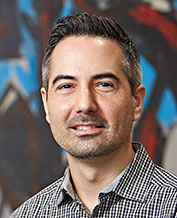
Tobias Merson, Ph.D.
Oligodendroglial Interactions Group
Research Topics
Dr. Merson’s research aims to advance our understanding of oligodendroglial cell function in the central nervous system. His interests span from neurodevelopment to ageing and extends to perturbations in oligodendroglial homeostasis that contribute to mental health disorders and neurodegenerative diseases. A central interest is to clarify how changes in myelination contribute to experience-dependent neuroplasticity. Studies from his team and others have revealed that myelination is regulated in an activity-dependent manner. The implications are that myelin plasticity could play a critical role in learning and memory. His team will explore the role that adaptive myelination plays in acquiring and consolidating learnt behaviors. Another key interest is to elucidate how myelin regeneration is executed at the cellular and molecular level. A particular focus is probing the function of distinct populations of stem and progenitor cells in oligodendrocyte regeneration. His approach combines genetic fate-mapping with single nuclei RNA sequencing to define the developmental trajectories, cell-state transitions and transcriptional dynamics of oligodendroglial progenitor cells as they differentiate into myelin-forming oligodendrocytes.
Biography
Dr. Merson is head of the Oligodendroglial Interactions Group. He received a BA/BSc(Hons) in romance languages, biochemistry and genetics in 1999 from the University of Queensland. In 2006, he received his Ph.D. from the University of Melbourne, where he investigated the role of the histone acetyltransferase Querkopf in adult neurogenesis. In 2007, he was awarded a postdoctoral fellowship by the National Health and Medical Research Council (NHMRC) and Multiple Sclerosis Research Australia (MSRA) to study mechanisms of myelin regeneration in the brain at the Howard Florey Institute. In 2013, he established his independent laboratory at the Florey Institute of Neuroscience and Mental Health as a Melbourne Neuroscience Fellow. In 2016, he was awarded a prestigious Australian Research Council Future Fellowship and moved to the Australian Regenerative Medicine Institute at Monash University to establish the Merson Group, where his team studied mechanisms that regulate myelin formation in health and disease. He joined the NIMH as a Staff Scientist in the spring of 2022.
Selected Publications
Moradi K, Mitew S, Xing YL, Merson TD (2024). HB-EGF and EGF infusion following CNS demyelination mitigates age-related decline in regeneration of oligodendrocytes from neural precursor cells originating in the ventricular-subventricular zone. bioRxiv 2024.02.26.582092; doi: https://doi.org/10.1101/2024.02.26.582092
Xing YL, Poh J, Chuang BHA, Moradi K, Mitew S, Richardson WD, Kilpatrick TJ, Osanai Y, Merson TD (2023). High-efficiency pharmacogenetic ablation of oligodendrocyte progenitor cells in the adult mouse CNS. Cell Rep Methods. 3, 100414. https://doi.org/10.1016/j.crmeth.2023.100414. [Pubmed Link ]
Truong PH, Ciccotosto GD, Merson TD, Spoerri L, Chuei MJ, Ayers M, Xing YL, Emery B, Cappai R (2019). Amyloid precursor protein and amyloid precursor-like protein 2 have distinct roles in modulating myelination, demyelination, and remyelination of axons. Glia. 67, 525-538. https://doi.org/10.1002/glia.23561. [Pubmed Link ]
Mitew S, Gobius I, Fenlon LR, McDougall SJ, Hawkes D, Xing YL, Bujalka H, Gundlach AL, Richards LJ, Kilpatrick TJ, Merson TD*, Emery B* (2018). Pharmacogenetic stimulation of neuronal activity increases myelination in an axon-specific manner. Nat Commun. 9, 306. https://doi.org/10.1038/s41467-017-02719-2. [Pubmed Link ]
Mitew S, Xing YL, Merson TD (2016). Axonal activity-dependent myelination in development: Insights for myelin repair. J Chem Neuroanat. 76, 2-8. https://doi.org/10.1016/j.jchemneu.2016.03.002. [Pubmed Link ]
Xing YL, Röth PT, Stratton JA, Chuang BH, Danne J, Ellis SL, Ng SW, Kilpatrick TJ, Merson TD (2014). Adult neural precursor cells from the subventricular zone contribute significantly to oligodendrocyte regeneration and remyelination. J Neurosci. 34, 14128-46. https://doi.org/10.1523/JNEUROSCI.3491-13.2014. [Pubmed Link ]
Oluich LJ, Stratton JA, Xing YL, Ng SW, Cate HS, Sah P, Windels F, Kilpatrick TJ, Merson TD (2012). Targeted ablation of oligodendrocytes induces axonal pathology independent of overt demyelination. J Neurosci. 32, 8317-30. http://doi.org/10.1523/JNEUROSCI.1053-12.2012. [Pubmed Link ]
NIHBC 49 - CONTE BG
49 Convent Drive
Bethesda, MD 20892
Phone: +1 301 793 3938
